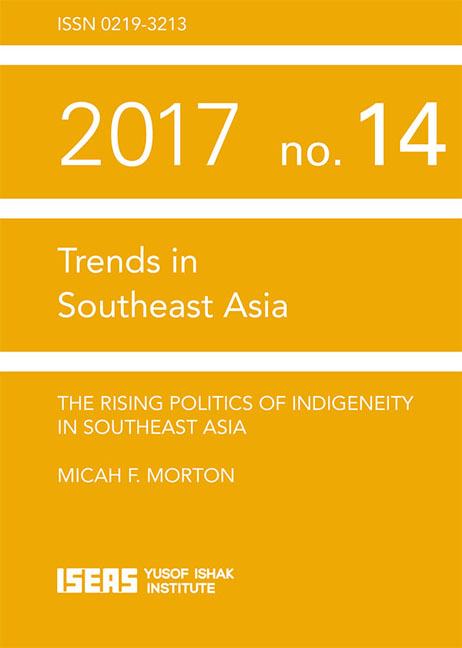The Rising Politics of Indigeneity in Southeast Asia
Published online by Cambridge University Press: 12 March 2019
Summary
INTRODUCTION
Throughout much of Southeast Asia and beyond, we are witnessing a resurgence of identity politics framed around notions of “nativeness” or “indigeneity” in opposition to “foreignness” or “otherness” (Dominguez and Metzner 2017). For example, in Myanmar and Thailand there is a rising trend among some members of the ethnic Burman and Thai Buddhist majorities towards the heightened politicization of Buddhism as an exclusive marker of the borders of national belonging (Hutt 2016; Jerryson 2011; Keyes 2016; Than 2015; Walton et al. 2017). In Indonesia, some groups are reviving an earlier public discourse of “pribumi-ism” (“indigenism”) alongside “political Islam” in order to address what are perceived as the ethnic roots of growing social inequalities in the country (Suryadinata 2017; Burhani 2017). Meanwhile, in Malaysia ethnic Malay nativism is on the rise as the ruling party attempts to shore up its support among the majority-Malay population (Lim 2016; Millar 2017). On the other side of the Straits of Johor in Singapore some nativists are making public assertions of “Singapore for Singaporeans” (Fenn 2014).
These resurgences of “nativism” are occurring at a particular juncture in history when states in the region are attempting to, first, exert more direct control over hitherto peripheral regions within their territorial borders, and, second, promote greater transregional economic integration within the utopian community of the Association of Southeast Asian Nations (ASEAN). These two processes of national and regional economic integration, while highly uneven and contested, are occurring hand in hand. In addition, while state-driven economic growth is generating great wealth throughout Southeast Asia, it is doing so in a highly uneven manner, leading to rising rates of inequality. On a more global scale, this resurgence is occurring amidst rising concerns over the ascendance of China and India to positions of global supremacy, and the waning of U.S. imperialism.
In the midst of these resurgences of “nativism” on the part of various national publics throughout Southeast Asia another related yet distinct movement being framed around altogether different notions of “Indigeneity” is occurring on the national and regional scale among diverse ethnic groups that have long experienced marginalization and oppression by more dominant ethnic groups during periods of European colonialism and post-colonial nationalism.
- Type
- Chapter
- Information
- The Rising Politics of Indigeneity in Southeast Asia , pp. 1 - 29Publisher: ISEAS–Yusof Ishak InstitutePrint publication year: 2017

